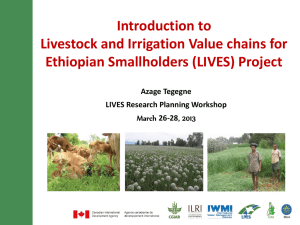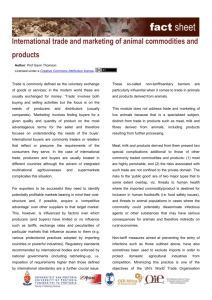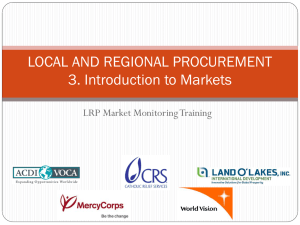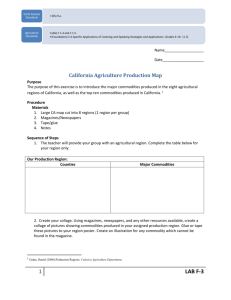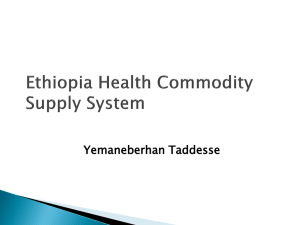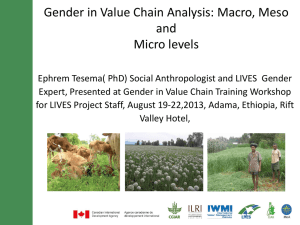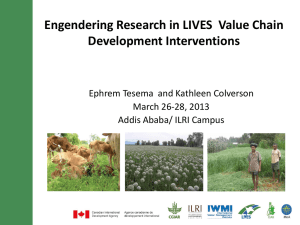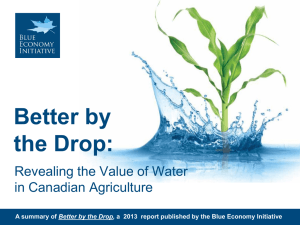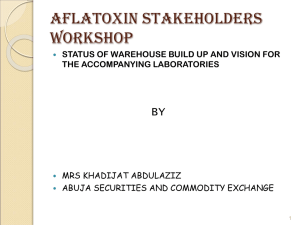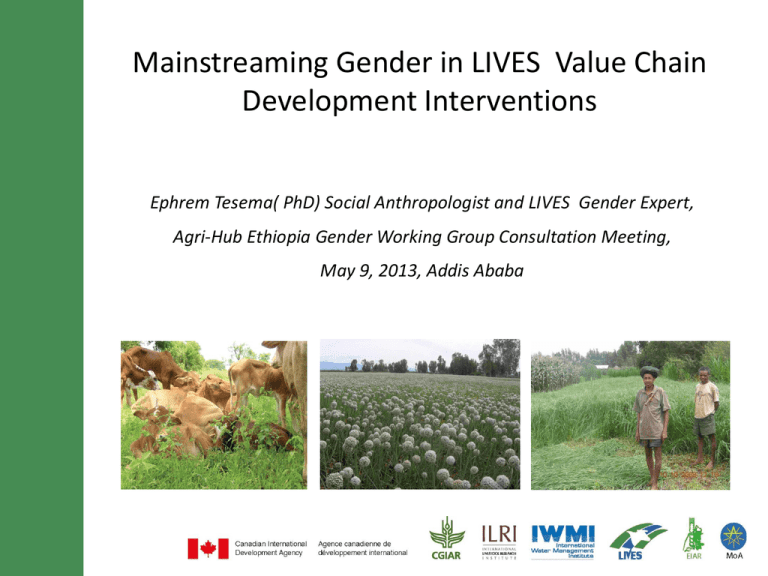
Mainstreaming Gender in LIVES Value Chain
Development Interventions
Ephrem Tesema( PhD) Social Anthropologist and LIVES Gender Expert,
Agri-Hub Ethiopia Gender Working Group Consultation Meeting,
May 9, 2013, Addis Ababa
Outline
•
The Rational for Gender Mainstreaming
• IntroducingLIVES Objectives, Scope, Target and VC Interventions
• Concerns on Gender in Agricultural VC
• LIVES Gender Strategy
• Directives
• Possible areas of Gender Interventions
• Gender in C. Building and K. Management
• Engendering research in Value chain Development intervention
The Rational for Gender Mainstreaming
• Social Justice
• Business
• Poverty Alleviation and Pro-poor VCI
Introducing LIVES Objectives, Scope, Target and VC Interventions
Ultimate Outcome - Improved income for male and female smallholder
producers and other value chain actors for key irrigated crop and
livestock products in a minimum of 30 districts in 10 target zones in the
region of Amhara, Oromia, Tigray, and SNNPR – 20% increase in income
Intermediate Outcome :
•
•
•
•
•
Value chain development of selected high value Livestock and
Irrigated Commodities
Capacity development targeting value chain actors, Service
|Providers and Educational/Research Institutions
Knowledge management by capturing, storing and sharing
knowledge through various interventions to fuel the value chain
development process
Engage in Research mainly focusing on Diagnosis, Action and
Impact Research activities
Promotion of the knowledge generated for scaling out beyond the
project areas
LIVES Commodities
• Commodities:
• Livestock
-Dairy,
-Beef,
-Small ruminants,
-Poultry,
-Apiculture) and
• High value Irrigated crops
-Vegetables
-Fruits
-Fodder
• Geographical - Ten (10) zones with clusters of Districts producing
selected commodities
LIVES Geographic Locations
LIVES Commodities Across Targeted Zones in Ethiopia
TABLE: Priority commodity value chains and their zonal locations selected by the four Regional
States
Region/Zone
Amhara
- Gondar
N/S*
- South Wollo
- West Gojam
Oromiya
- E Shoa
Beef
/live
animals
Chicken
meat/eggs
Honey
& bee
wax
Milk
SR meat/
live
animals
Fruits
Vegetables
Total
-
-
-
√
-
(√)
√
(10)
2
-
-
-
√
√
√
4
-
-
-
√
√
√
√
√
4
(12)
4
-
-
-
- W Shoa
√
-
√
- Jimma
-
-
√
SNNPR
- Gamo Gofa
-
√
- Sidama**
-
√
√
-
√
√
√
√
-
√
√
√
√
√
-
-
-
-
√
-
-
Tigray
- Central
-
-
-
√
- Eastern
-
-
Total
1
2
√
4
√
8
√
-
√
√
√
√
-
6
6
√
8
Note: N – North, S – South, E – East, W – West; *growth corridor ** Hawassa milkshed
4
4
(5)
3
2
(8)
4
4
35
Concerns Gender on Agricultural VC
•
•
•
•
Strange Bedfellows ?
A buzz word and a lip Service?
Difficult but achievable?
Focusing on high value commodities may encourage the bypassing
of women?
• Implications for the Agricultural Sector
It affects the long term sustainability of the envisioned growth and
transformation objective of the Agricultural Sector
LIVES Gender Strategy
• Capitalize on IPMS findings and Lessons
• Findings documented during LIVES PIP
• LIVES Baseline Survey
• Guided by and adhering to LIVES Logic Model
• Capitalize on CIDA funded project experiences
A Gender Lens in commodity/ Enterprise Development
• Commodities and value chain nodes traditionally dominated by
women
• Commodities and value chain nodes conventionally involve men
and women
• Commodities and value chain nodes conventionally dominated
by men only.
Directives for Successful Gender Sensitive Interventions in
LIVES
• Set specific Gender targets for LIVES Intervention that captures the
imagination of staff and partners and facilitate support for its
successful achievements.
• Learn from and share the experience of successful gender sensitive
VC Governance
• Present evidence and facts to raise the awareness of project
partners regarding the Importance of gender in value chain
development initiative. Do not preach!!
• Prepare a gender action plan and scan the plan and all project
activities with gender lens, share with partners and project staff
Directives for Successful Gender Sensitive Interventions in
LIVES
• Learn and share gender analytical tools and approaches for
successful delivery
• Work in partnership with the respective Women’s Affair Offices and
other gender sensitive public and private service delivery
organizations
• Understanding the gender context of the priority commodity/ value
chains through diagnostic process and by making continues follow up
studies
• Collecting and analyzing site and priority value chain specific
information on gender differences in division of labor in producing
and marketing priority commodities
Directives for Successful Gender Sensitive Interventions in
LIVES
• Identify the extent of access to and control over resources and benefits
accrued to men and women from specific commodities and value chain
nodes
• gender participation in decision making capacity needs to be engaged in
priority commodity value chain development
• Developing strategies to address gender issues in commodity chains
with partners
• Identifying opportunities and implementing strategies to enable women
and men to have equal opportunities in the project activities
• Identifying constraints and opportunities for women’s participation in
the selected value chains
Possible Areas of Interventions
• Targeting women from female‐headed households who have land
for vegetable production
• Targeting women to engage in input supply systems like fruit tree
nurseries, pullet production, feed block preparation
• Involving women and women groups in value addition/processing
(e.g. juice and honey processing)
• Giving more focus and support to women in women‐dominated
enterprises (e.g. dairy and poultry)
• Adapting enterprises to more effectively engage and increase
benefits to women, e.g., honey production in modern beehives
Possible Areas Cont’d
• Supporting women to identify and develop joint enterprises like
small ruminant fattening
• Facilitate linkage to micro-finance institutions and other financial
sources to enhance access to credit and market linkages for
women to better Increase the participation of women in value
chain development
• Evaluating these approaches to understand which strategies
work, where and under what conditions
• Engaging women water‐users’ associations to increase access to
irrigation technologies and enhance decision making role in
tapping the resources
•
Using participatory technology adaptation and evaluation
approaches that enhance women’s participation such as farmer
participatory research, Field days,
Capacity Building and Knowledge Management
• Involve women from FHH& MHH
• Sex disaggregated data (E.g. on LIVES Graduates)
• Gender Disaggregated Outcomes (Research Topics)
• Gender sensitive approach on CB and KM for LIVES
Engendering research in Value chain Development
intervention
• Major areas of focus
-Participatory Process/involve key stakeholders
-Use a format to capture key research agendas, set time frame,
responsible stakeholders and the expected outcome
-Opt for the types of research that suites the specific project
objectives ( Diagnostic, Action Research, Using the result for
rectifying problems, Monitoring, Impact evaluation and
Learning etc.
Approaches ( Setting Realistic Objectives)
• To increase equity of gender roles in value chain nodes and chain
governance of high value livestock commodities and irrigated crops
• To increase gender sensitive knowledge management and capacity
building interventions in high value livestock commodities and irrigated
crops
• To ensure whether gender sensitive approaches are used by LIVES’s
research and development partners
• Monitoring, Impact/outcome Evaluation and Action Learning
Gender Sensitive Research Steps in
Value Chain Development
• Map Gender Roles & Relationships along the VC
• Identify gender constraints along the VC
• Assess the consequences of the gender constraints
• Identify and implement actions to overcome constraints
• Carry out Action Research to measure Outcomes/impacts
• Measure outcomes of implementations
Integrating Gender in Agricultural VC
6.Measuring
Outcomes
1. Mapping
Gender Roles and
Relations along
the VC
2. Moving
5. Action
Research
from Gender
inequality to
Constraints
4. Taking
Action
3. Assessing the
Consequences of
Constraints
Gender sensitive knowledge management and capacity
building research approach
•
Identify formal/informal institutions involved in brokering
capacity development
•
Identify knowledge and capacity development methods used by different
institutions
•
Identify knowledge management/capacity building institutions and methods that
ensure access for men and women
•
Identify constraints, Opportunities and its implications on gender
•
•
propose gender sensitive knowledge/capacity development intervention
Action Research
•
Measuring the outcomes of the intervention/action
knowledge and
Gender sensitive Knowledge Management and capacity building
Research outputs/outcomes
• Examples of diagnostic research output
– Role of informal institutions/farmer to farmer in knowledge sharing by
and for women
– Couples training
– Involvement of young family members in FHH
• Action research To Verify the proposed interventions resulted from the
Diagnostic proposal
• Impact Research ( Measuring the outcomes)
Learning and Sharing: Knowledge Dissemination and Capacity Enhancement by innovative Female
Farmer In Ada’a District Oromia
W/ro Elfinesh Bermeji, a female smallholder in Ada’a district in Oromia, share her experiences on backyard beekeeping for AGP trainees, Photo
by Ephrem Tesema, November 18, 2011
Thank You!
Together We Can!!
www.lives-ethiopia.org



